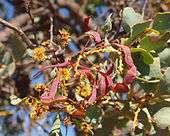Acacia inaequilatera
| Kanji bush | |
|---|---|
 | |
| A. inaequilatera, in flower. | |
| Scientific classification | |
| Kingdom: | Plantae |
| (unranked): | Angiosperms |
| (unranked): | Eudicots |
| (unranked): | Rosids |
| Order: | Fabales |
| Family: | Fabaceae |
| Genus: | Acacia |
| Species: | A. inaequilatera |
| Binomial name | |
| Acacia inaequilatera Domin | |

Acacia inaequilatera, commonly known as kanji bush or baderi, is a tree in the family Mimosaceae. Endemic to Australia, it is widely distributed in the semi-arid Triodia country eastwards from Karratha, Western Australia into the Northern Territory.
Kanji bush is a gnarled tree with corky bark and spiny foliage and stems. It grows to a height of between two and five metres. Like most Acacia species, it has phyllodes rather than true leaves. These are a blue-grey colour, with a curved midrib and a short spine at the tip. There is also a pair of curved spines at the base of each leaf. Unusually for Acacia species, the flowers are not pure yellow, but rather yellow with a reddish purple centre. These are held in spherical clusters about five millimetres in diameter. The pods are flat and curved, up to ten centimetres long and one centimetre wide.
Kanji bush is very fire tolerant and colonises rapidly after a bushfire. It is short-lived, lasting less than ten years.
References
| Wikispecies has information related to: Acacia inaequilatera |
| Wikimedia Commons has media related to Acacia inaequilatera. |
- "Acacia inaequilatera". Flora of Australia Online. Department of the Environment and Heritage, Australian Government.
- "Acacia inaequilatera". FloraBase. Western Australian Government Department of Parks and Wildlife.
- Mitchell, A. A.; Wilcox, D. G. (1994). Arid Shrubland Plants of Western Australia, Second and Enlarged Edition. University of Western Australia Press, Nedlands, Western Australia. ISBN 1-875560-22-X.